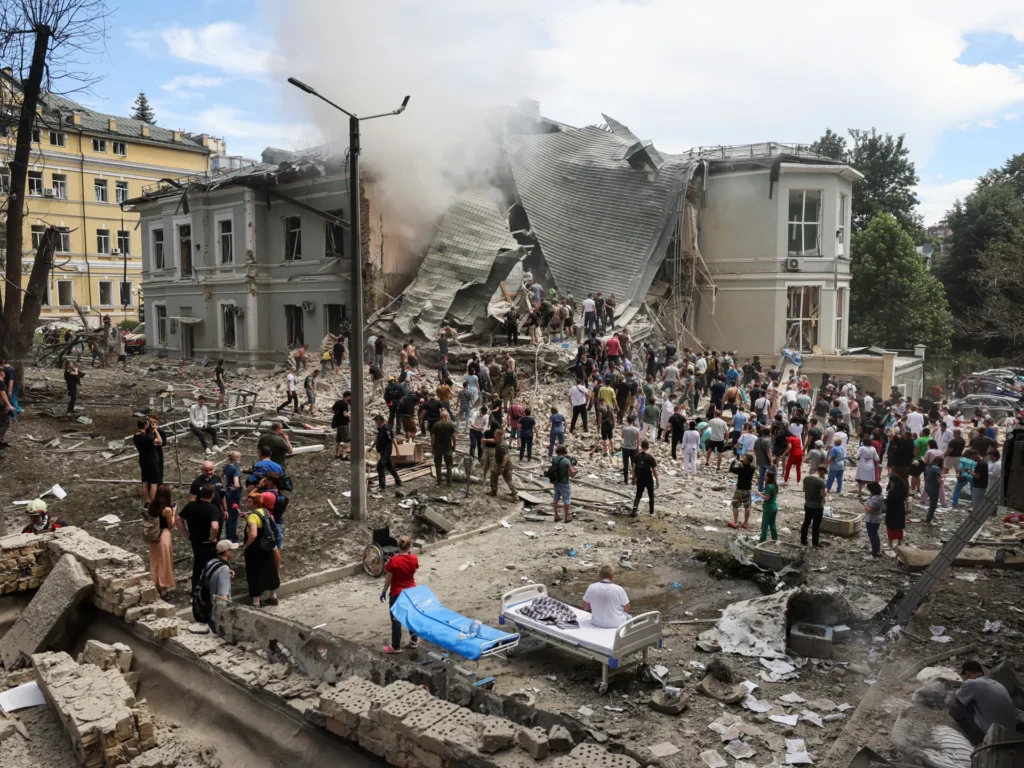Unprecedented Drone and Missile Strike Devastates Kyiv, Odesa, and Poltava
In a major escalation of the war, Russia launched its biggest drone and missile attack on Ukraine on July 4, 2025, unleashing 539 Iranian-made Shahed drones and 11 long-range ballistic and cruise missiles. According to defense analysts, the assault—described as the largest aerial bombardment of Ukraine in 2025—lasted for hours overnight and primarily targeted Kyiv, Odesa, and Poltava. As a result, this drone swarm overwhelmed Ukraine’s air defenses and caused significant damage to residential buildings, energy infrastructure, and foreign diplomatic sites, including the Polish Embassy and Chinese Consulate. More importantly, the loss of external power at the Zaporizhzhia Nuclear Power Plant triggered emergency generators and immediately sparked global concern about a potential nuclear disaster.
Ukraine Intercepts 270 Drones Using Patriot Systems, But Civilians Suffer
In response, Ukraine quickly activated its air-defense systems, including U.S.-supplied Patriot missiles, S-300s, and advanced electronic jamming technologies. These systems managed to intercept approximately 270 drones and 2 missiles. Nevertheless, the attack still inflicted severe damage on homes, schools, and public infrastructure. In particular, falling drone debris struck densely populated districts, killing at least one civilian and injuring 23 others. Consequently, military analysts view the assault as more than just a tactical strike; they believe Russia deliberately timed the attack just hours after a private conversation between Vladimir Putin and Donald Trump. In fact, experts interpret this move as a bold act of geopolitical intimidation aimed directly at the West.
Patriot Missile Shortage and Delayed Western Support Fuel Ukraine’s Vulnerability
Notably, this aggressive military maneuver occurred during a temporary suspension of U.S. air-defense aid to Ukraine, which exposed critical gaps in Kyiv’s protective shield. As expected, President Volodymyr Zelensky publicly criticized the delay, emphasizing Ukraine’s reliance on Western-supplied systems like Patriot missile batteries and anti-drone jamming equipment. Shortly after the strike, Trump reportedly contacted Zelensky, stating, “They’re going to need them for defense,” thereby acknowledging the urgency and severity of the situation. At the same time, the International Atomic Energy Agency (IAEA) issued an urgent statement, calling for demilitarization of the Zaporizhzhia nuclear zone, and warning that continued attacks could lead to Europe’s worst nuclear crisis since Chernobyl.

Ukraine Retaliates with Drone Strikes on Russian Milita
Meanwhile, Ukraine swiftly retaliated by launching precision drone and missile strikes on Russian military installations, specifically targeting airfields and radar sites in Belgorod, Kursk, and Bryansk. Clearly, these cross-border attacks marked a tactical shift—from a purely defensive stance to active disruption of Russian operations. Russian officials reported power outages, infrastructure damage, and civilian injuries caused by falling debris. However, Ukrainian commanders emphasized that they carefully selected targets to disable future drone launch sites, mirroring the same types of attacks Russia has repeatedly inflicted on Ukrainian cities over the past year.
July 4 Attack Signals Turning Point in Russia–Ukraine War
Ultimately, the July 4, 2025 drone and missile assault on Kyiv and other cities represents a turning point in the war. It not only exposed Ukraine’s air-defense vulnerabilities but also highlighted the strategic ruthlessness of Russia’s drone warfare tactics. As the conflict intensifies, the escalating use of high-volume drone attacks has emerged as a defining feature of modern warfare, pressuring NATO, the EU, and the U.S. to respond more decisively. Moving forward, global attention is now fixated on Ukraine’s next steps, and the need for increased Patriot systems, advanced anti-drone technology, and financial support has never been more urgent. Whether this attack signals the beginning of a wider Russian offensive or triggers stronger Western intervention remains uncertain—but the world is watching.
